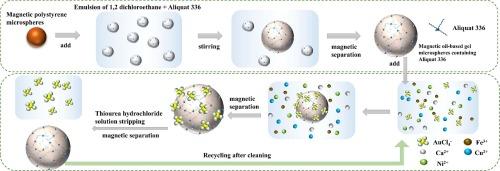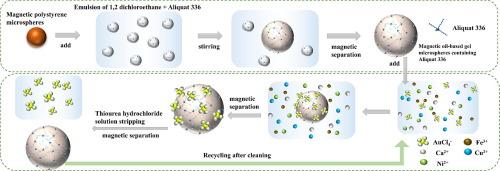An innovative microextraction material for efficient and selective extraction of gold: Magnetic oil-based gel microspheres containing Aliquat 336
IF 13.2
1区 工程技术
Q1 ENGINEERING, CHEMICAL
引用次数: 0
Abstract
The recovery of low-concentration Au(III) from industrial wastewater holds significant economic and environmental value. Therefore, developing materials for the efficient extraction of low-concentration Au (III) is of great importance. In this study, we propose a novel microextraction scheme that combines the characteristics of microextraction with an extractant curing technique. Magnetic polystyrene microspheres serve as containers to encapsulate the extraction phase, which consists of the extractant (Aliquat 336) and the diluent (1,2-dichloroethane). Magnetic polystyrene microspheres with a diameter of 3.69 μm were swollen using an emulsion containing Aliquat 336 and 1,2-dichloroethane, resulting in the formation of magnetic oil-based gel microspheres with a diameter of 10.14 μm. These magnetic oil-based gel microspheres, which also contain Aliquat 336, are composed of 1,2-dichloroethane (81.73 wt%), Aliquat 336 (11.52 wt%), polystyrene (4.36 wt%), and iron tetroxide (1.69 wt%). At a low oil-to-water (O:A) ratio (ranging from 1:40 to 1:100), the microspheres achieved extraction equilibrium within 8 min. An eluent solution containing 0.1 mol·L−1 hydrochloric acid and 0.05 mol·L−1 thiourea was able to completely reverse the extraction of AuCl3 from the microspheres, facilitating their regeneration. The microspheres demonstrated stable and effective extraction capabilities over four cycles. In the presence of impurity ions (Ca2+, Fe3+, Cu2+, and Ni2+), the extraction rate of gold by the microspheres exceeded 95 %, while the extraction rate of the impurity ions remained below 10 %. This indicates the excellent selective extraction ability of the microspheres for Au(III).


一种用于高效和选择性提取金的创新微萃取材料:含有Aliquat 336的磁性油基凝胶微球
从工业废水中回收低浓度金(III)具有重要的经济和环境价值。因此,开发高效萃取低浓度Au (III)的材料具有重要意义。在这项研究中,我们提出了一种新的微萃取方案,将微萃取的特点与萃取剂固化技术相结合。磁性聚苯乙烯微球作为容器封装萃取相,萃取相由萃取剂(Aliquat 336)和稀释剂(1,2-二氯乙烷)组成。用含有Aliquat 336和1,2-二氯乙烷的乳液对直径为3.69 μm的磁性聚苯乙烯微球进行膨胀,得到直径为10.14 μm的磁性油基凝胶微球。这些磁性油基凝胶微球也含有Aliquat 336,由1,2-二氯乙烷(81.73 wt%)、Aliquat 336(11.52 wt%)、聚苯乙烯(4.36 wt%)和四氧化二铁(1.69 wt%)组成。在低油水比(O: a)(范围为1:40 ~ 1:100)下,微球在8 min内达到萃取平衡。含有0.1 mol·L−1盐酸和0.05 mol·L−1硫脲的洗脱液能够完全逆转AuCl3从微球中的萃取,促进其再生。微球在四个循环中表现出稳定有效的萃取能力。当杂质离子(Ca2+、Fe3+、Cu2+、Ni2+)存在时,微球对金的提取率超过95 %,对杂质离子的提取率低于10 %。说明该微球对Au(III)具有良好的选择性萃取能力。
本文章由计算机程序翻译,如有差异,请以英文原文为准。
求助全文
约1分钟内获得全文
求助全文
来源期刊

Chemical Engineering Journal
工程技术-工程:化工
CiteScore
21.70
自引率
9.30%
发文量
6781
审稿时长
2.4 months
期刊介绍:
The Chemical Engineering Journal is an international research journal that invites contributions of original and novel fundamental research. It aims to provide an international platform for presenting original fundamental research, interpretative reviews, and discussions on new developments in chemical engineering. The journal welcomes papers that describe novel theory and its practical application, as well as those that demonstrate the transfer of techniques from other disciplines. It also welcomes reports on carefully conducted experimental work that is soundly interpreted. The main focus of the journal is on original and rigorous research results that have broad significance. The Catalysis section within the Chemical Engineering Journal focuses specifically on Experimental and Theoretical studies in the fields of heterogeneous catalysis, molecular catalysis, and biocatalysis. These studies have industrial impact on various sectors such as chemicals, energy, materials, foods, healthcare, and environmental protection.
 求助内容:
求助内容: 应助结果提醒方式:
应助结果提醒方式:


